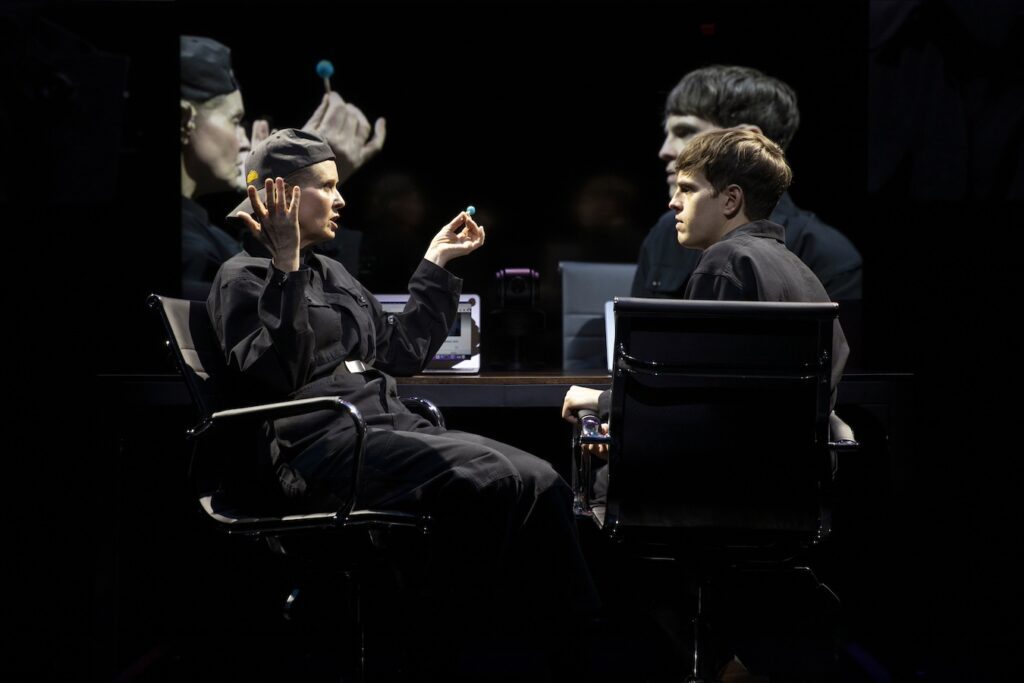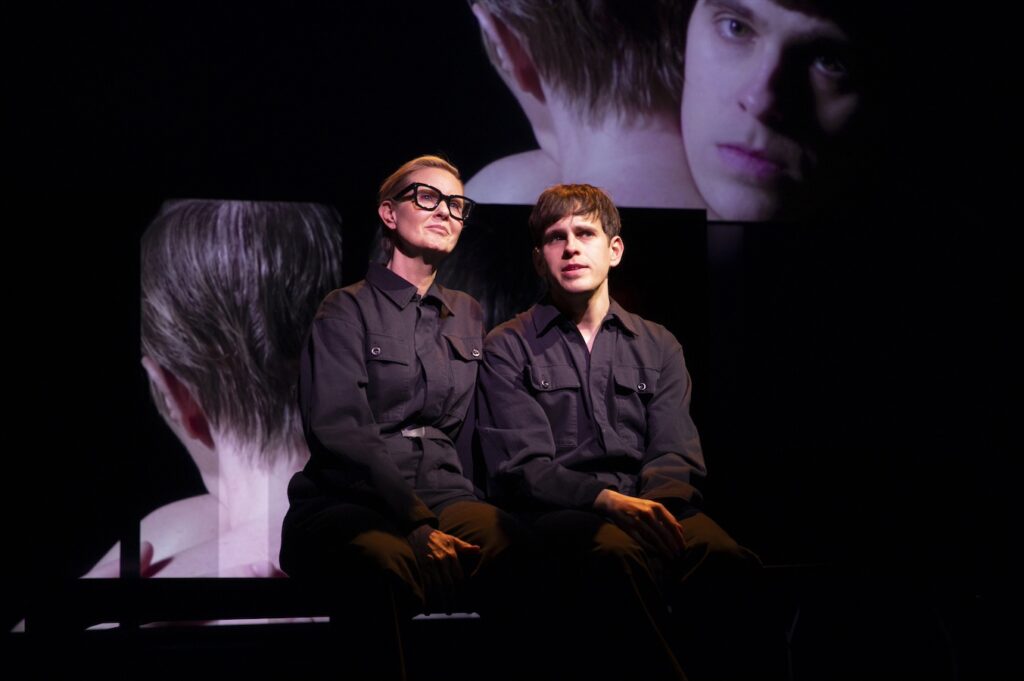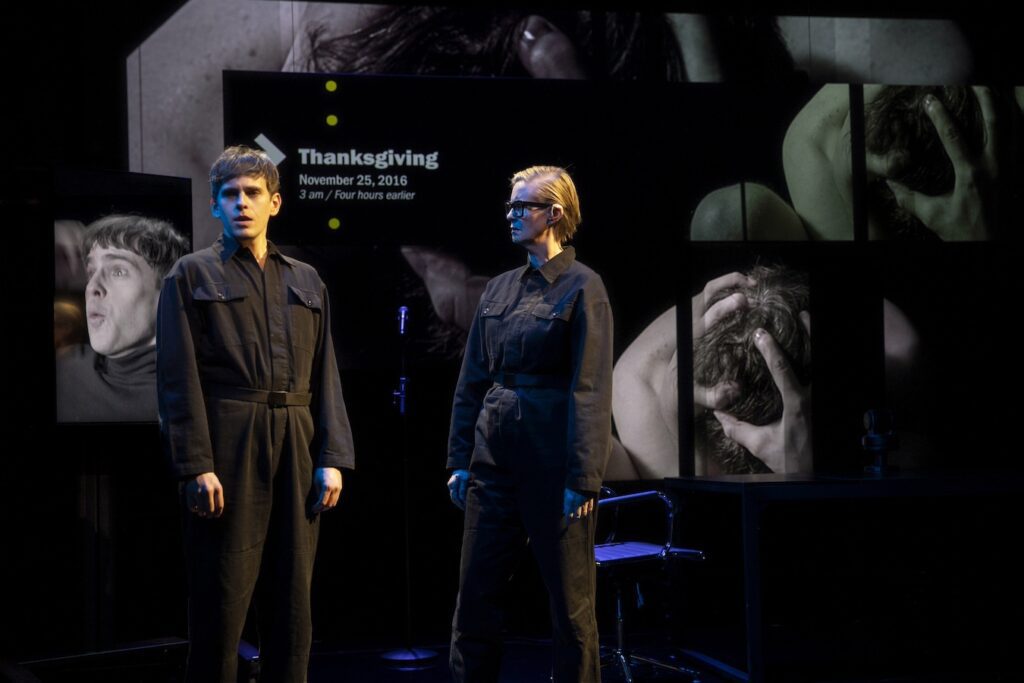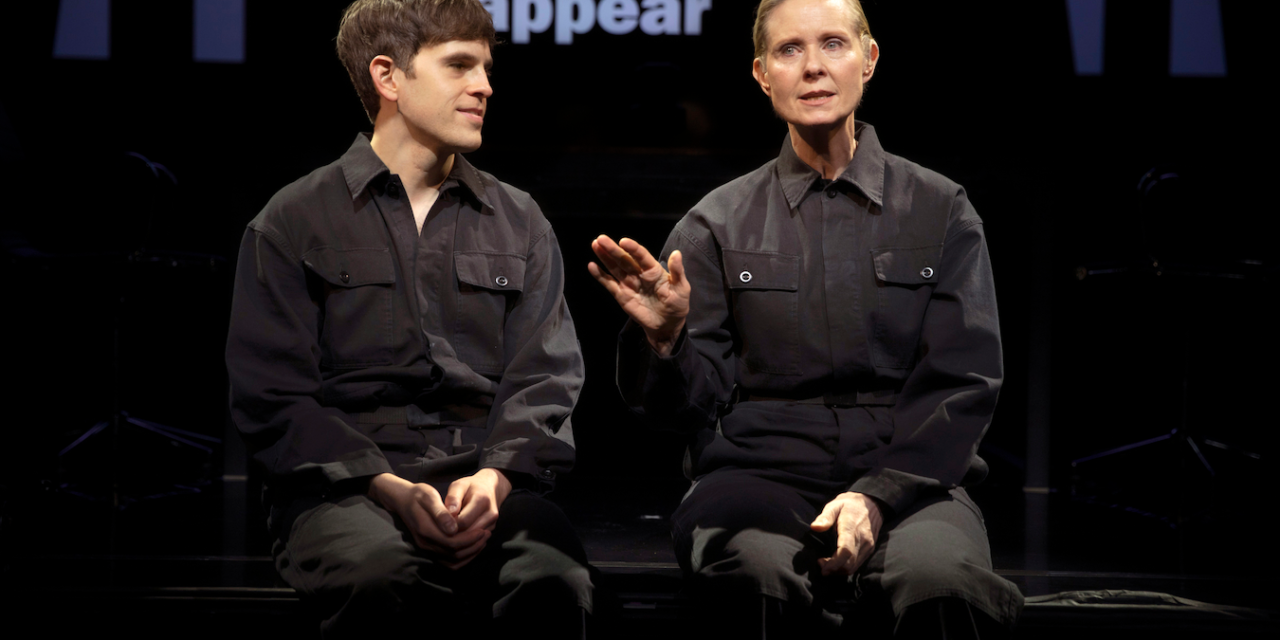Theater Review by Samuel L. Leiter . . . .
I met Jordan Seavey, playwright of The Seven Year Disappear, the New Group’s current production at the Pershing Square Signature Center, only once, and just briefly enough to shake his hand and say hello. I must, however, disclose, as I did for his Homos, or Everyone in America, the small-world fact that I’ve known his mother longer than I have any still-living non-family member of mine. We knew each other from first grade, in 1946, all the way through college, resuming our acquaintance when social media became a thing. On the other hand, despite The Seven Year Disappear being about a fraught mother-son relationship, I have no clue as to how autobiographical it is, although most parent-child plays reflect some degree of personal experience, if not as overtly as Williams’s The Glass Menagerie. Perhaps I’ll learn someday.
Occupying 16 titled scenes (like “Curator,” “Two-Faced Bitch,” and “Guardian Angel”), including a Prologue and an Epilogue, over the course of three “Movements,” each charted on a screen at the beginning, this uninterrupted, hour and 40-minute drama introduces us to the world of durational performance artists. It even references one of the genre’s major figures, Marina Abramović, the leading rival of the play’s fictional heroine, Miriam (Cynthia Nixon), who’s jealous because Abramović is being given a show at the Whitney, which Miriam insists is “mine.” (Jordan Seavey’s mother, herself a skilled theater writer, was also an unconventional performer, although in a surprisingly different medium.)

However, if you know neither what performance art—the kind involved here—is, nor what Miriam’s work consists of, you’re on your own, because Seavey treats it as a given. This makes all the play’s many pronouncements about “art” seem rather tenuous or, if you’re familiar with but skeptical about performance art, pretentious. What the playwright makes clear, though, is that it involves the artist’s considerable personal exposure. In Miriam’s case, this involves both her and her now grown son, Naphtali (Taylor Trensch, intense), who has been an essential part of her work since he was a baby, a kind of appropriation against which he eventually rebels.
The mother-worshipping Naphtali, a former abuser of both booze and drugs, is also Miriam’s business manager; the pair is also Jewish, although Miriam is a convert, Judaism adding another arrow to her quiver of ways she justifies her art. One of Naphtali’s preoccupations, which Miriam is reluctant to resolve, concerns his father’s identity, a question eventually, if somewhat conventionally, answered.
When, in 2009, Naphtali informs his mother that MOMA is planning to commission her next work, the ecstatic Miriam somehow takes it as a cue to disappear from public view—even Naphtali doesn’t know her whereabouts—on the night of the official announcement. She returns seven years later—at Thanksgiving in 2016—her absence having been designed as the foundation for her new piece, which, conceived of as a work of “reconciliation,” is designed in the form of a confessional for her and Naphtali.


To explore what happened, mainly to Naphtali, during those seven years, Seavey takes liberties with dramatic form, creating a nonlinear structure that moves freely around in time, many scenes retreating backward in Betrayal style, and even adding material from Naphtali’s childhood. Following the timeline, however, becomes increasingly puzzling, especially as all the non-Naphtali people are played by Nixon (seven, in addition to Miriam) in a series of two-character scenes. Further blurring things is the choice to dress both Nixon and Trensch throughout in the same kind of simple black jumpsuits (designed by Qween Jean), like well-dressed garage mechanics or factory workers, creating a look that can only be described as dystopian.
Such costumes evoke a sense of character neutrality that, for all the play’s occasionally impassioned moments, projects an indefinite cerebral quality, only rarely conveying emotionally direct, rather than actorly, communication. Should you zone out at any time, it’s easy to forget which character Nixon—her reddish-blond hair in a boyish bob—is playing, except, perhaps, when she’s using a German accent, vaping, or wearing glasses. Good as she is—when is she not?—I wouldn’t rate this a tour de force demonstration of thespian versatility.
Nixon’s roles, which range from the teens to middle-aged, male and female, include Wolfgang, a bisexual German gallery owner and former lover of Miriam, with whom Naphtali has been intimate; a gay blind date named Braden, an assistant curator for MOMA, who, hoping to dig up information on Miriam, has a confrontation with Naphtali that causes the latter to fall off the wagon; Tomás, another gay lover of Naphtali, a DACA Dreamer, who’s a coworker with him on Hillary Clinton’s failed presidential campaign (Naphtali having abandoned art for politics); Kaitlyn, a high school girl manicurist who paints Naphtali’s nails “Millenium Pink,” and, stretching the limits of plausibility, happens to be something of a modern art savant, even being familiar with her client’s mother; Nicole, a missing persons investigator to whom Naphtali resorts in the early days of Miriam’s disappearance; Michael, an Episcopal bishop who’s both gay and a drug dealer; and Aviva, Naphtali’s actress friend.


As time moves—mostly, but not entirely—in reverse, we hear lots of talk about gay sex (tops and bottoms not to mention fisting, fucking, and sucking); liberal politics, as per the 2016 campaign; art world chatter and theory; Miriam’s mental state; memories of an important childhood incident at the Bronx Zoo, which we eventually see for ourselves; thoughts about what happens after death; and, inevitably, this being the art world, the scourge of HIV. Some of this is undeniably interesting, but most of it ends up being little more than undramatic filler.
Director Scott Elliott’s fast-paced but unilluminating production is staged on Derek McClane’s modernistic, non-localized setting of sleek tables, rolling desk chairs, and video screens of varying dimensions. It makes considerable use of live video and stills (projections by John Narun), mostly of magazine-worthy closeups, creating an impression resembling nothing so much as one of those Zoom productions presented during the pandemic. At least one passage even replicates the technique in which people in separate spaces are shown reaching across contiguous screens as if sharing the same locale. There’s also an extensive use, for certain conversations, of live mics, a currently overused theatrical trope that seems present more for its avant-gardish trendiness than its necessity. Both Jeff Croiter’s incisive lighting design and Rob Milburn and Michael Bodeen’s pitch-perfect sound design contribute effectively to the cool aura surrounding the events.
It was seven years ago that I called Jordan Seavey’s Homos, or Everyone in America “funny, thoughtful, touching, and pertinent.” I regret not being able to use such words for The Seven Year Disappear, but I hope it’ll be less than seven years before I get to see the next offering from this talented playwright.
The Seven Year Disappear. Through March 31 at the Pershing Square Signature Center/Alice Griffin Jewel Box Theatre (480 West 42nd Street, between Ninth and Tenth Avenues). www.thenewgroup.org
Photos: Monique Carboni


















